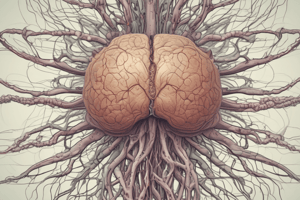Podcast
Questions and Answers
What is the primary function of the nervous system?
What is the primary function of the nervous system?
- To produce red blood cells and platelets
- To produce hormones and regulate growth
- To control and coordinate body functions (correct)
- To filter waste and excess fluids from the blood
Which part of the nervous system interprets and integrates sensory information?
Which part of the nervous system interprets and integrates sensory information?
- Peripheral nervous system
- Somatic nervous system
- Central nervous system (correct)
- Autonomic nervous system
What is the role of motor neurons in the nervous system?
What is the role of motor neurons in the nervous system?
- To transmit sensory information from sensory receptors to the CNS
- To transmit signals from the CNS to muscles and glands (correct)
- To integrate and process information within the CNS
- To regulate body temperature and blood pressure
What is the function of interneurons in the nervous system?
What is the function of interneurons in the nervous system?
What are the chemical messengers released by neurons that transmit signals across synapses?
What are the chemical messengers released by neurons that transmit signals across synapses?
What is the function of the somatic nervous system?
What is the function of the somatic nervous system?
What is the gap between neurons where neurotransmitters are released and bind to receptors?
What is the gap between neurons where neurotransmitters are released and bind to receptors?
What is the electrical signal that travels along the length of a neuron, allowing it to transmit information?
What is the electrical signal that travels along the length of a neuron, allowing it to transmit information?
Flashcards are hidden until you start studying
Study Notes
Overview
- The nervous system is a complex system that allows the body to respond to internal and external stimuli
- It is responsible for controlling and coordinating body functions, interpreting and responding to sensory information, and facilitating thought and behavior
Structure
- Central Nervous System (CNS): +Brain and spinal cord +Interprets and integrates sensory information +Controls voluntary movements and actions
- Peripheral Nervous System (PNS): +Sensory neurons that transmit information from sensory receptors to the CNS +Motor neurons that transmit signals from the CNS to muscles and glands +Divided into somatic nervous system (voluntary movements) and autonomic nervous system (involuntary functions)
Functions
- Sensory Function: detects and interprets sensory information from the environment
- Motor Function: transmits signals from the CNS to muscles and glands to produce responses
- Integration: integrates sensory information and facilitates thought, behavior, and emotional responses
- Control: regulates various bodily functions, such as heart rate, blood pressure, and body temperature
Types of Neurons
- Sensory Neurons: transmit sensory information from sensory receptors to the CNS
- Motor Neurons: transmit signals from the CNS to muscles and glands
- Interneurons: integrate and process information within the CNS
Neurotransmission
- Neurotransmitters: chemical messengers released by neurons that transmit signals across synapses
- Synapses: small gaps between neurons where neurotransmitters are released and bind to receptors
- Action Potential: electrical signal that travels along the length of a neuron, allowing it to transmit information
Overview
- The nervous system responds to internal and external stimuli, controlling and coordinating body functions, interpreting sensory information, and facilitating thought and behavior
Structure
- The Central Nervous System (CNS) consists of the brain and spinal cord, interpreting and integrating sensory information and controlling voluntary movements
- The Peripheral Nervous System (PNS) includes sensory neurons transmitting information from sensory receptors to the CNS, and motor neurons transmitting signals from the CNS to muscles and glands
- The PNS is divided into the somatic nervous system (voluntary movements) and autonomic nervous system (involuntary functions)
Functions
- The sensory function detects and interprets sensory information from the environment
- The motor function transmits signals from the CNS to muscles and glands to produce responses
- The integration function integrates sensory information and facilitates thought, behavior, and emotional responses
- The control function regulates bodily functions, such as heart rate, blood pressure, and body temperature
Types of Neurons
- Sensory neurons transmit sensory information from sensory receptors to the CNS
- Motor neurons transmit signals from the CNS to muscles and glands
- Interneurons integrate and process information within the CNS
Neurotransmission
- Neurotransmitters are chemical messengers released by neurons that transmit signals across synapses
- Synapses are small gaps between neurons where neurotransmitters are released and bind to receptors
- An action potential is an electrical signal that travels along the length of a neuron, allowing it to transmit information
Studying That Suits You
Use AI to generate personalized quizzes and flashcards to suit your learning preferences.




